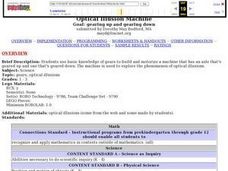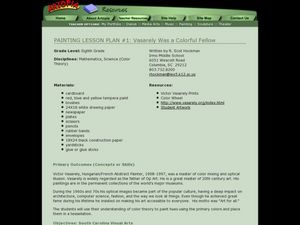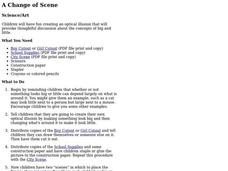Curated OER
Mysterious Melodies
Students play brain tricks on one another. In this brain instructional activity, students cut out cards to show one another. They try to trick the other person into reading the cards incorrectly and look at other optical illusions.
Curated OER
Optical Illusion Machine
Young scholars explore optical illusions. Using Legos, they construct and motorize a machine that has an axle that's geared up and geared down, complete a worksheet, and answer discussion questions.
Curated OER
Vasarely Was A Colorful Fellow
Eighth graders create artwork inspired by the work of Victor Vasarely. In this op art lesson plan, 8th graders explore color theory and color mixing. Students create ten shapes to use in their artwork and over the course of two weeks,...
Curated OER
A Change of Scene
Students create their own optical illusions by making something look big and then changing what's around it to make it look little.
Curated OER
Anamorphosis
Students classify optical illusions according to their distinguishing characteristics. They create anamorphic art and use Mylar flexible mirrors to view and then they describe and analyze the optical illusion.
American Museum of Natural History
Trip Up Your Brain
Sometimes different parts of the brain disagree. See what this disagreement looks like using a remote learning resource to experience how brains often take shortcuts. Pupils complete the activity, observe their results, and then read...
LABScI
Vision Lab: The Eye
Our bodies have some amazing capabilities, but there are some limitations. Explore the limitations of the human eye through the eighth lab activity in a series of 12 biology lessons. Individuals measure their own peripheral vision and...
University of Minnesota
Welcome To Your Senses
Sound, sight, taste, touch, and smell—oh the world of senses! What do these five senses have to do with the brain? The answer: everything. Explore how the brain sends and receives messages by having the class participate in several sense...
Curated OER
Weather Internet Scavenger Hunt
In this earth science worksheet, students visit the weather sites listed to answer the weather questions on the sheet. They define super cell and complete the paragraph. Students also name and sketch three types of snowflakes.
Curated OER
Mystery of the Senses-Vision
Students view six optical illusions and explain why the visual system might interpret them the way it does. They explore how illusions distort our sense of perspective, because they deceive us into seeing what we expect to see. ...
Curated OER
Psychedelic Checkerboard Op Art
Students analyze optical illusions from the packets, both individually and as a class. They create an original optical illusion design using pattern and repetition. They determine which color needs to be in the pattern.
Curated OER
Mechanism of Vision
Students explore the eye and its vision. For this science lesson plan, students learn the way light reflected from objects enters the eye, the basic anatomy and physiology of the eye, and the basic mechanism of perception.
Curated OER
Science
Third graders study light and shadow, participate in mirror activities, and build a periscope.
Exploratorium
Touch the Spring
Concave mirrors and the images they produce are traditional topics in the physics classroom. This resource explains how to set up an investigation of them, and it provides you with the explanation of concepts.
Curated OER
Would You Believe Your Eyes?
Learners study the parts and functions of the human eye. They create dodecagons which are twelve-sided figures with twelve equal angles and share these with the class so that each student can begin to see how many different illusions can...
Curated OER
Perception and the Brain
Students experience how the brain adapts over time to changes in what they perceive. In this human perception lesson, students wear special prism goggles that initially disorient the user. Over time, the student is able to adjust to the...
Curated OER
Vision Of The Future
Students investigate ways in which new vision tests and technologies can be used to help detect and correct vision problems. They begin by reading the Times article, Software May Replace the Eye Chart on the Wall. They stage a medical...
Curated OER
Stations of Light
Student groups rotate through four stations to examine light energy behavior: refraction, magnification, prisms and polarization. They see how a beam of light is refracted (bent) through various transparent mediums. Students investigate...
Curated OER
Reflection, Refraction & Lenses
Students are able to describe what happens to light when it strikes different materials. They describe the law of reflection. Students are able to explain why a mirror froms a virtual image. They are able to describe diffuse reflection.
Curated OER
How We See
Students study how images they see are transmitted to the brain. In this sight lesson students complete several activities that have to do with visual pathways and field defects.
Curated OER
Ptolemy, Copernicus, & the Church
High schoolers determine the difference between a geocentric universe and a heliocentric universe.
Curated OER
Star Systems
Students study a star system and see how the planets move around stars. In this star system lesson students complete an activity and see what an eclipse is.
Curated OER
Exploring the Left and Right Sides of the Brain
Explore the Human brain. Students become familiar with the left and right hemispheres of the human brain and engage in activities that activate powers that are dominant in each hemisphere.
Curated OER
Animal Myth Busters
In these reading comprehension worksheets, students read about animal myths and animal facts. Students answer 5 reading comprehension questions about the text.

























